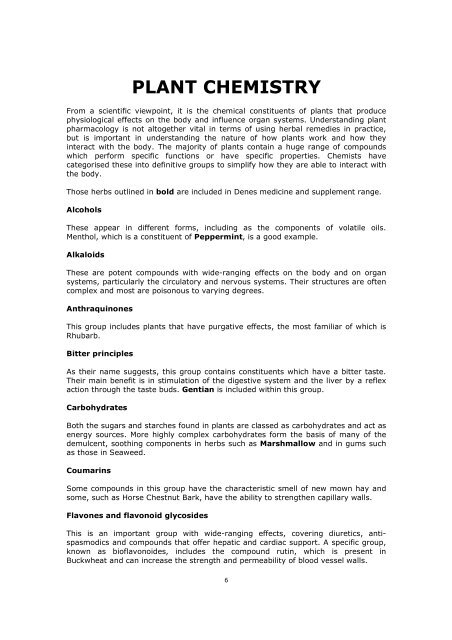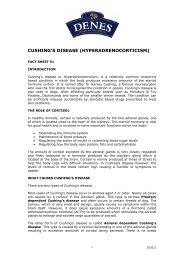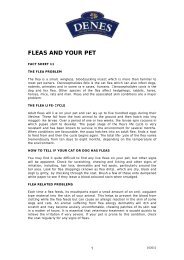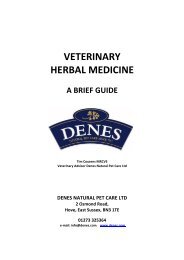VETERINARY HERBAL MEDICINE - Denes Natural Pet Care
VETERINARY HERBAL MEDICINE - Denes Natural Pet Care
VETERINARY HERBAL MEDICINE - Denes Natural Pet Care
You also want an ePaper? Increase the reach of your titles
YUMPU automatically turns print PDFs into web optimized ePapers that Google loves.
PLANT CHEMISTRY<br />
From a scientific viewpoint, it is the chemical constituents of plants that produce<br />
physiological effects on the body and influence organ systems. Understanding plant<br />
pharmacology is not altogether vital in terms of using herbal remedies in practice,<br />
but is important in understanding the nature of how plants work and how they<br />
interact with the body. The majority of plants contain a huge range of compounds<br />
which perform specific functions or have specific properties. Chemists have<br />
categorised these into definitive groups to simplify how they are able to interact with<br />
the body.<br />
Those herbs outlined in bold are included in <strong>Denes</strong> medicine and supplement range.<br />
Alcohols<br />
These appear in different forms, including as the components of volatile oils.<br />
Menthol, which is a constituent of Peppermint, is a good example.<br />
Alkaloids<br />
These are potent compounds with wide-ranging effects on the body and on organ<br />
systems, particularly the circulatory and nervous systems. Their structures are often<br />
complex and most are poisonous to varying degrees.<br />
Anthraquinones<br />
This group includes plants that have purgative effects, the most familiar of which is<br />
Rhubarb.<br />
Bitter principles<br />
As their name suggests, this group contains constituents which have a bitter taste.<br />
Their main benefit is in stimulation of the digestive system and the liver by a reflex<br />
action through the taste buds. Gentian is included within this group.<br />
Carbohydrates<br />
Both the sugars and starches found in plants are classed as carbohydrates and act as<br />
energy sources. More highly complex carbohydrates form the basis of many of the<br />
demulcent, soothing components in herbs such as Marshmallow and in gums such<br />
as those in Seaweed.<br />
Coumarins<br />
Some compounds in this group have the characteristic smell of new mown hay and<br />
some, such as Horse Chestnut Bark, have the ability to strengthen capillary walls.<br />
Flavones and flavonoid glycosides<br />
This is an important group with wide-ranging effects, covering diuretics, antispasmodics<br />
and compounds that offer hepatic and cardiac support. A specific group,<br />
known as bioflavonoides, includes the compound rutin, which is present in<br />
Buckwheat and can increase the strength and permeability of blood vessel walls.<br />
6










